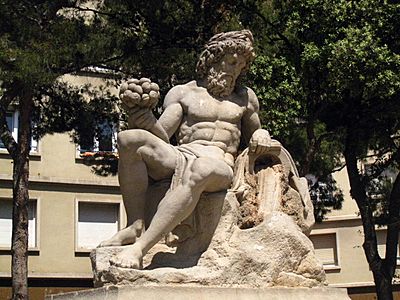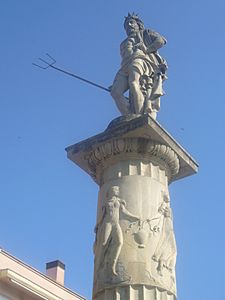Damià Campeny facts for kids
Quick facts for kids
Damià Campeny
|
|
|---|---|
| Born |
Damià Campeny i Estrany
12 April 1771 |
| Died | 17 July 1855 (aged 84) |
| Nationality | Spanish |
| Known for | Sculpture |
| Movement | Classicism |
Damià Campeny i Estrany (born April 12, 1771, in Mataró – died July 17, 1855, in Barcelona) was a famous Spanish sculptor. He created beautiful artworks in the Classical style, which was popular during his time.
Biography
Damià was born to Andreu Campeny, a shoemaker, and his wife Casilda. He first went to a private Catholic school. After finishing his early schooling, he studied art at the Escola de la Llotja in Barcelona.
He also worked in the workshops of other sculptors. First, he learned from Salvador Gurri i Corominas, and later, he worked with Nicolau Travé. After gaining experience, Damià opened his own art studio. He started getting requests to create religious sculptures for churches nearby.
In 1797, Damià received a special grant from the Board of Trade. This money allowed him to continue his art studies in Rome, Italy. While in Rome, he met the very famous sculptor, Antonio Canova. Damià spent eighteen years working at the Vatican workshops. During this time, he created many sculptures based on myths, like those of Hercules and Neptune. Many of these artworks were sent back to Spain for the Board of Trade.
When Damià returned to Barcelona, he became a teacher at his old school, the Escola de la Llotja. In 1819, he was made the head of the sculpture department there. He was also offered a teaching job at the Real Academia de Bellas Artes de San Fernando in Madrid, but he turned it down. However, he did accept a position as the Court Sculptor for King Ferdinand VII.
Damià also became an academician at other art schools. These included the Escola de Sant Lluís in Zaragoza and the Real Academia de Bellas Artes de San Carlos de Valencia. In 1850, he became one of the first teachers at what is now the Reial Acadèmia Catalana de Belles Arts de Sant Jordi. This happened even though some people worried about his age and health.
Despite his success, Damià faced financial difficulties. He had many disagreements about his salary and payments for his sculptures. His health got worse, and he passed away at his home in Sant Gervasi de Cassoles, which is now part of Barcelona.
Today, you can find Damià Campeny's artworks in several places. These include the MNAC, the Reial Acadèmia Catalana de Belles Arts de Sant Jordi, and the Biblioteca Museu Víctor Balaguer in Vilanova i la Geltrú. In 1999, a special exhibition of his works was held at the Museu Frederic Marès.
Selected works
-
The Fountain of Neptune (1832), Igualada
See also
 In Spanish: Damià Campeny para niños
In Spanish: Damià Campeny para niños




